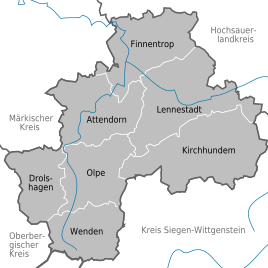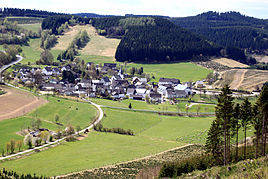Schliprüthen
|
Schliprüthen
Finnentrop municipality
|
||
|---|---|---|
| Coordinates: 51 ° 14 ′ 0 ″ N , 8 ° 5 ′ 0 ″ E | ||
| Height : | 447 m above sea level NHN | |
| Residents : | 146 (December 31, 2016) | |
| Incorporation : | 1st July 1969 | |
| Postal code : | 57413 | |
| Area code : | 02724 | |
|
Location of Schliprüthen in the district of Olpe |
||
|
View of Schliprüthen from the Rührberg
|
||
Schliprüthen is a district of Finnentrop in the Olpe district in North Rhine-Westphalia with around 150 inhabitants.
General
The place is located in the Sauerland-Rothaargebirge nature park and is a typical Sauerland village. He is the namesake of the southern part of the Homertrück, known as Schliprüther Homert . The old Sauerland architectural style of half-timbered houses has remained in many buildings to this day. The village is 430 m above sea level in a side valley of the Salwey , with the mountains surrounding the place reaching up to almost 600 m above sea level. Schliprüthen is also located on the SauerlandRadring .
history
The oldest objects that document a stay of people in the neighboring area of the Fretter - the Frettertal - come from the Neolithic Age (4500–1800 BC). In 1905 a polished, pierced ax made of crystalline rock and a stone ball 10 cm in diameter were found near the Fretter spring . In 1955, during field work in the neighboring village of Serkenrode, a Neolithic rectangular ax made of greywacke was found. Until around the year 500, the mountainous area between the middle Lenne and the Wenne , in the middle of which Schliprüthen is today, seems to have been a deserted forest wilderness. However, the first smaller settlements must have existed by 800 at the latest. Between 900 and 1000 the population in the Fretter area increased more. Proof of this is the archaeologically proven construction of a larger church in Schönholthausen . The first written mention of the place Schliprüthen seems to be in a register around 1150. The first undisputed mention is found in the goods classification of Count William of Arnsberg of 1313, which states that Luscede Schliprüthen with a hoof in Schliprüthen invested is. Early clues about the size of Schliprüthen result from an appraisal register (used to collect taxes) from 1543. According to this, there were nine taxpayers in "Schliprüden" (spelling at that time) at that time. The number of those liable for the treasury is likely to have roughly matched the existing families or houses.
According to a more recent study of the place names in the Olpe district, the interpretation of the place name is difficult. The basic word “ -rüden ” could be motivated by the earlier vegetation and could be interpreted as “reed-covered place” based on the old Saxon hriudi . The reference syllable "- slip ", based on the Middle Low German "-slip" (iron slag or wood that is tied together) can be an indication that iron processing or wood extraction also took place at the location. According to Floer, other interpretations are also possible.
With the entry into force of the law on municipal reorganization in the district of Olpe , the Serkenrode office and the Schliprüthen municipality ceased to exist after 126 years of existence with effect from July 1, 1969. At the same time the new municipality of Finnentrop was formed. She was the legal successor to the Serkenrode office.
religion
The vast majority of the population professes the Catholic faith.
The villages Schliprüthen, Fehrenbracht, Dormecke and Wedekinghausen were grouped together in the Schliprüthen parish chapel until 1186 and belonged to the original parish of Wormbach .
The small late Romanesque hall church of St. Georg Schliprüthen belongs to the same type as the parish church in Dünschede , after which this type, which is very common in the region, is named. It has two square yokes with round pillars and dome-like vaults. The choir bay is narrow and has a semicircular apse. There are side apses in the very narrow aisles.
literature
- Serkenrode and the parish Schliprüthen in the Sauerland region of Cologne. Edited by the Catholic parishes of St. Johannes Bapt., Serkenrode, and St. Georg, Schliprüthen. Paderborn undated (1991)
- Johannes Dornseiffer: Historical news from Schliprüthen. Mescheder Zeitung 1903
- Benedikt and Franz-Josef Huss: Church of St. Georg Schliprüthen. Catholic parish St. Georg Schliprüthen, 2008
Web links
- Schliprüthen in the Westphalia Culture Atlas
Individual evidence
- ↑ Population statistics for the municipality of Finnentrop (as of December 31, 2016). (PDF) Municipality of Finnentrop, accessed on May 16, 2017 .
- ↑ The population of the Electoral Cologne Sauerland in 1543, page 91 ( Memento of October 3, 2011 in the Internet Archive )
- ↑ cf. in detail Michael Flöer: The place names of the district of Olpe. Westfälisches Ortsnamesbuch (WOB), Verlag für Regionalgeschichte, Bielefeld 2014, pp. 213 to 215
- ↑ Martin Bünermann: The communities of the first reorganization program in North Rhine-Westphalia . Deutscher Gemeindeverlag, Cologne 1970, p. 89 .
- ↑ see also Georg Dehio (greeting), Ursula Quednau (arrangement): Nordrhein-Westfalen, Bd. 2: Westfalen ( Handbuch der deutschen Kunstdenkmäler ). Deutscher Kunstverlag , Berlin / Munich 2011, ISBN 978-3-422-03114-2 , page 330




